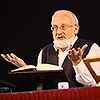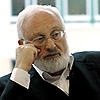Audio Version Of The Blog – 2/12/20
Listen to an Audio Version of the Blog
Download:MP3 Audio

Listen to an Audio Version of the Blog
Download:MP3 Audio
 Humanity is one big vessel, one soul, called Adam HaRishon. In order to be corrected, this vessel is split into two: Israel and the nations of the world. We cannot correct it all at once because there are some very deep layers that the light cannot reach right away.
Humanity is one big vessel, one soul, called Adam HaRishon. In order to be corrected, this vessel is split into two: Israel and the nations of the world. We cannot correct it all at once because there are some very deep layers that the light cannot reach right away.
All corrections start with the easier ones, progressing toward more difficult ones. Thus, the first to be corrected are the upper, lighter layers, as it is said about Israel that it is “small among the nations,” meaning that it has the lightest type of desire to enjoy. And in the nations of the world the desire is much heavier, which will appear when they start to awaken.
Each person that receives the awakening toward spirituality in our days is a part of the common soul called Israel (Yashar Kel), straight to the Creator. They must hurry with their correction because their main work consists of helping the other desires, the nations of the world.
Israel channels the light that reforms through itself, through its unity. Then the nations of the world awaken and begin their corrections, demanding more light from Israel until everyone unites into one soul, as it is written: “My house will be called the house of prayer for all nations.” Israel must correct itself in order to correct the whole of humanity.1
The people of ancient Babylon were called the “generation of discord.” This was the time when the common soul of Adam HaRishon was split into two: Galgalta ve Eynaim (GE) and Awzen Hotem Peh (AHP), into the head and the body of the desire, into Israel and the nations of the world. Babylonian society was divided into these two camps.
It is said that this was the generation that started humanity’s decline. Before that time, the egoistic desire, which needed correction, did not exist. Beginning with it, the part called Israel has an obligation to correct its egoistic desire into an altruistic one.
This was the generation of Abraham. Abraham is the force that divided humanity into two parts with the appeal: “Who is for the Creator—come join me!” And “Love will cover all crimes.”
Before that, the desire to enjoy was so small in people that all Babylonians intuitively felt what the correct behavior should be and naturally followed it. They spoke the same language and lived as one family.
But by the time of Abraham, the desire to enjoy grew, and they broke their old idols not knowing what to do about their egoism. It is said that Abraham defeated the idols, but in fact, it was an entire process taking place with all the people. They did not know how to keep on living, so part of the nation followed Nimrod with his egoistic method of correction, calling them to fulfill the American dream. And the other part followed Abraham, who called for them to become Israel, to aspire to the Creator.
To worship the Creator means to follow the force of connection. All commandments aim us at connection within the tens in order to become as a ten to one union, one group, one understanding. This is the essence, the meaning, and the purpose of commandments because we need to correct the broken vessel.2
From Adam to Abraham, humanity kept developing and its desire to enjoy grew. Inside a person, who was still an animal, human qualities began to emerge, i.e., egoism. He started separating himself from the rest of the people: his wife, children, his own house, possessions, work, property, trade.
Everyone felt more and more distanced from others until it came to the point that they began fighting among each other and believing in different idols, i.e., different forces. An idol is not just a mere statue that one bows down to; there is a deep internal philosophy that stands behind it. It is active in people to this day and we see that the world still has a great separation between all religions, each one worshiping its own symbol. This entire breakage began in ancient Babylon.
The desire to enjoy keeps growing step by step, causing certain consequences: Shoresh de Shoresh, Alef de Shoresh, Bet de Shoresh, Gimel de Shoresh, Dalet de Shoresh (0-0, 1-0, 2-0, 3-0, 4-0). The development on level zero has come to an end and level 1 has begun: 0-1, 1-1, 2-1, etc. So, the desire kept on growing until Galgalta ve Eynaim stopped developing and Abraham appeared as its consequence.
Abraham is the connection of Bina and Malchut. Thus, he can be the father to the nation, meaning to give Malchut the quality of Bina. Therefore, Abraham breaks the idols showing that it is Bina, the quality of bestowal, that should be worshiped instead of Malchut, reception. Bestowal becomes our God, and this is the whole difference between Abraham and Nimrod.
This was is ideological. There are only ten Sefirot, Galgalta ve Eynaim and AHP, the relationship between the broken vessels and the work toward correction.3
Abraham was the first man who created the link between Bina and Malchut. He raised his Malchut to Bina in 40 years during which he started to attain the Creator, the quality of bestowal, Bina. This is how he created his methodology and started teaching it to others.4
It is said that “the world stands on three pillars: the Torah, spiritual work, and kindness.” The order is: Abraham—Isaac—Jacob. Abraham is Chesed, kindness, the light of Hassadim. This is the light that reforms, our preparation for work. The work is Isaac, Gevura, strength. Through this work we come to Jacob—Torah, Tifferet. This is the process we must go through.
The light comes, we work on our connection and reveal the Creator within our unity.
The “three pillars that the world stands on” are Abraham, Isaac, and Jacob. Abraham is Chesed, a man of kindness who exerted efforts in bringing people to kindness. Isaac is the pillar of work who put himself on the “sacrificial altar”; meaning, he sacrificed himself for the work, strength. The sacrificial altar refers to our desire to enjoy that we keep working on as we sacrifice it, wanting to change it to the desire to bestow.
Jacob is called “the man of the Torah.” Torah is the middle line that we arrive at through hard work on our egoism, with the force of Abraham, meaning, due to the work of Isaac, strength (overcoming). All the sufferings of Jacob represent the struggle with the evil inclination.
The order of the work:
1. We receive the force from above called Abraham.
2. We work hard on our desire to enjoy this force in order to organize it correctly—this is called the work of Isaac.
3. We then arrive at the middle line, the connection between the quality of the light, the intention to bestow, the quality of the desire, and they all merge into the middle line called Jacob.5
From the 1st part of the Daily Kabbalah Lesson 1/15/20,” Israel’s Duty Toward Humanity”
1 Minute 0:20
2 Minute 7:30
3 Minute 13:00
4 Minute 19:00
5 Minute 23:40
Related Material:
Was Adam HaRishon Phoenician?
Puzzle “Adam HaRishon”
Was There Really Adam HaRishon?

The Times of Israel published my new article “Racist Attitudes Toward Ethiopian Jews Displays Need to Unite Above Differences”
What do Israelis think about Ethiopian immigrants?
One third of Israelis “would not marry an Ethiopian Jew and would not want any family member to do so,” according to data from a recent survey commissioned by Israelis Against Racism. The disturbing data further revealed that “22% believe the Jewish religious identity of Ethiopians is questionable,” and 16% “did not want to live in the same building or even the same neighborhood as Ethiopian Jews.” Despite living as part of Israeli society for more than 40 years, the amount of racism in Israel toward the Ethiopian community is still astounding.
Sadly, the painful survey results do not entirely surprise me. When I immigrated to Israel in the early 1970s, the theater, cinema and TV programs were peppered with the poison of racist humor: Sephardi, Ashkenazi, Persian, Moroccan and Kurdish Jews would all poke fun at each other. The air of the country was soaked with ethnic ridicule, which I found disgusting.
Add to the general atmosphere of insensitive humor at the expense of ethnic newcomers, the long marginalization Israel’s Ethiopian-Jewish community faced regarding their Jewish status, differences in mentality and culture, and the barriers that have prevented full Ethiopian integration into Israeli society become clear.
As if that is still insufficient, there is a human tendency to be suspicious of anyone who looks different from us, speaks a foreign language, and holds customs foreign to ours. I saw this in myself when, as a child, I gaped at the strange Georgian fruit sellers in the Leningrad markets only to be shocked to discover when I grew up that they were fellow Jews.
In many ways, Israel is a microcosm of the increasingly globalized world in which we live. Israelis literally come from all over the world, each with our unique cultures, characters and approaches to life. We are Asian, European, American, Latin, Middle Eastern, and African all packed together onto a tiny piece of land, in a hostile neighborhood, under great pressure, and as such, cannot be expected to get along without frictions.
However, Israelis can learn to appreciate and complement each other, and we must—for ourselves, and as an example to the world that needs to learn this skill just as badly as we do. However, it is going to take more than political pacts, religious policy changes, and positive public icons to unite us. Unity above our differences requires consistent methodical education. Education is a necessary precedent to complete the healing of the general rift in Israeli society and the fragmentation that destroys us on a daily basis.
Over many generations, Kabbalists have devised an educational method specifically suited for our times and circumstances. It teaches us how to recognize the divisive egoistic drives within us, making us connect to stigmas and nationalities instead of transcending them with unifying values above the differences. What the struggles of Israel’s Ethiopian-Jewish community can show us is the extent to which we live in denial of discrimination, and the true extent of conflict and separation among the Jewish people.
Primary to this form of education is the learning of how to pattern society according to the laws of nature—laws of connection, giving, equality and love. By comprehending how nature works to unify all of its parts, we can apply the same altruistic tendency to realize true balance in Israel’s pluralistic society.
By acknowledging divisive drives as part and parcel of human nature, we can then use such tendencies to build a new layer of positive connections upon them, according to the principle, “love will cover all transgressions.”
The heartbreaking statistics of discrimination against Israel’s Ethiopian-Jewish community should highlight the extent of the division in Israeli society, how much it hurts us, and the need for us to unite above it. We need no more than to be aware of the division that tramples our unity, and then springboard to a reconstruction of a new unified society above our differences “as one man with one heart.”
 Question: Will good and evil exist until I fully begin to perceive that everything is from the Creator?
Question: Will good and evil exist until I fully begin to perceive that everything is from the Creator?
Answer: Yes, and then evil will become the absolute good.
Question: When a person begins to study the wisdom of Kabbalah, they understand that they are opposite to the Creator and they feel the Light as evil. But in spite of this, something holds them on this path and helps. What is it?
Answer: The purpose of creation draws one forward. A person must know why he or she exists. Otherwise, life has no meaning.
Question: How, besides feeling that everyone owes me, can I feel that I owe everyone too? What do I owe everyone?
Answer: You owe everyone your good attitude.
Question: What is “our world”?
Answer: Our world is what you see with your senses and nothing more.
Question: We perceive everything that happens in life with our senses. But how do we change what we perceive: ourselves or the world? What can we change at all?
Answer: We can change something only through our attitude toward ourselves and toward the world, that is, toward the Creator. It is only this way that we begin to perceive ourselves in a different and better way, not in any other way.
Question: Why did the Creator make so many religions if He is one?
Answer: The multitude of religions, faiths, and all kinds of approaches and philosophies were created specifically so that a person would choose from them and find the right way to the Creator for oneself. By having so many ways in front of us and by choosing one of them, we become “complex.”
[252660]
From KabTV’s “Fundamentals of Kabbalah,” 7/21/19
Related Material:
Blitz Of Kabbalah Tips – 7/14/19
Blitz Of Kabbalah Tips – 6/23/19
Blitz Of Kabbalah Tips – 6/16/19, Part 2
 Question: Kabbalah says that we should not be ashamed of our desires and properties. Then what are transgressions in Kabbalah?
Question: Kabbalah says that we should not be ashamed of our desires and properties. Then what are transgressions in Kabbalah?
Answer: Any evil action in relation to other people and even inanimate, vegetative, and animate nature, any egoistic action in relation to the world around us is a transgression. It is a lot worse than a transgression in relation to the Creator.
A person needs to be careful not to cause any harm even to the surrounding nature. He must see everything around him as a manifestation of the Creator.
Therefore, one must treat inanimate, vegetative, and animate nature as well as people equally with absolute kindness. The Creator will perceive this as an attitude toward Him. This attitude in no way can be other than a person’s attitude to the surrounding world.
[257945]
From KabTV’s “Fundamentals of Kabbalah,” 12/1/19
Related Material:
Judging Yourself
Covering Transgressions With Unified Love
Remove The Heavy Burden From The Soul
Lesson Preparation
| [media 1] | [media 2] |
Lesson on the Topic “Despair from his own Forces”
| [media 3] | [media 4] |
Selected Highlights
| [media 5] | [media 6] |